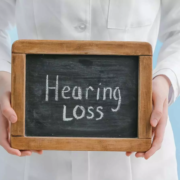New study sheds light on language development in children with hearing loss

A University of Miami study offers new insights into language development in children with hearing loss, suggesting language learning strategies that may help children with cochlear implants-surgically implanted hearing devices-overcome initial language development delays.
The study, conducted by University of Miami College of Arts and Sciences researchers Lynn K. Perry and Daniel S. Messinger and University of Miami Leonard M. Miller School of Medicine researcher Ivette Cejas, sheds light on the relationship between early vocabulary knowledge and later language development in children with cochlear implants.
The researchers focused on the proportion of shape-based nouns in children’s initial vocabularies. Shape-based nouns are words like “chair” or “cup” that describe a category of objects based on their shape, rather than other characteristics such as color or material.
Their findings, published in Developmental Science, show that a higher proportion of shape-based nouns in a child’s vocabulary shortly after cochlear implantation was associated with better language development for the next three years.
The researchers also found that the association between the shape-based nouns and long-term language development was stronger in children who had received cochlear implants, compared to children with normal hearing. The results have implications for efforts to help children with hearing loss surmount initial language delays caused by a lack of auditory input and access to speech sounds before they receive cochlear implants.
“Learning more shape-based nouns seemed to affect both how many words they knew and also their grammar skills and other aspects of language,” said Perry, the first author on the paper and an associate professor in the Department of Psychology. “Especially for the children with cochlear implants, it was such a strong predictor that even three years later, we were able to account for some of the differences in their language skills.”
The data used in this study was collected as part of the Childhood Development after Cochlear Implantation Study, a national, multi-site longitudinal study. The researchers analyzed data on the language abilities of young children with cochlear implants prior to their implantation surgery and every six months after implantation. They also looked at data on children with normal hearing who were recruited from preschools.
The study, which was supported by the National Institute on Deafness and Other Communication Disorders of the National Institutes of Health, found that the children with a larger proportion of shape-based nouns in their vocabularies shortly after implantation had larger vocabularies at a year, two years, and three years after implantation. They also scored higher on standardized tests of other language abilities, and they were more likely to have caught up with their peers with normal hearing.
Previous studies have indicated the importance of shape-based nouns in the language development of children with normal hearing, and that picking up on this pattern in early-learned English vocabulary can help children to acquire new words. But prior to this study, little was known about the role of shape-based nouns in the language development of children with cochlear implants.
“This is a real experiment in nature showing that the types of words a child knows shape their language development,” said Messinger, a professor in the Department of Psychology. “It’s remarkable that these effects were strongest for cochlear implant users, perhaps because shape-based nouns guided their word learning after implants gave them access to hearing.”
The findings suggest that knowing shape-based nouns facilitates children’s language development and may help to make up for initial language delays in children with cochlear implants.
“While cochlear implants have become the standard of care for children with bilateral severe to profound hearing loss, there continues to be significant variability in their spoken language development,” said Cejas, a professor and the director of family support services in the Department of Otolaryngology at the Miller School of Medicine. “Our work highlights a potential avenue for intervention that may aid in closing the vocabulary and language gap that exists for some of these children.”
Although the study found an association between the initial proportion of shape-based nouns in a child’s vocabulary and later language development, the researchers said further investigation is needed to establish a causal link.
They also noted that they don’t yet know why some children had a larger proportion of shape-based nouns in their vocabulary than others.
“Both within the group of children who have cochlear implants and children in general, we do see differences in terms of what words children learn first,” Perry said. “I think figuring out where those differences come from will be important to knowing how to best support all learners.”
Reference:
Lynn K. Perry, Daniel S. Messinger, Ivette Cejas, Vocabulary Composition Shapes Language Development in Children With Cochlear Implants, Developmental Science, https://doi.org/10.1111/desc.13588
Powered by WPeMatico











